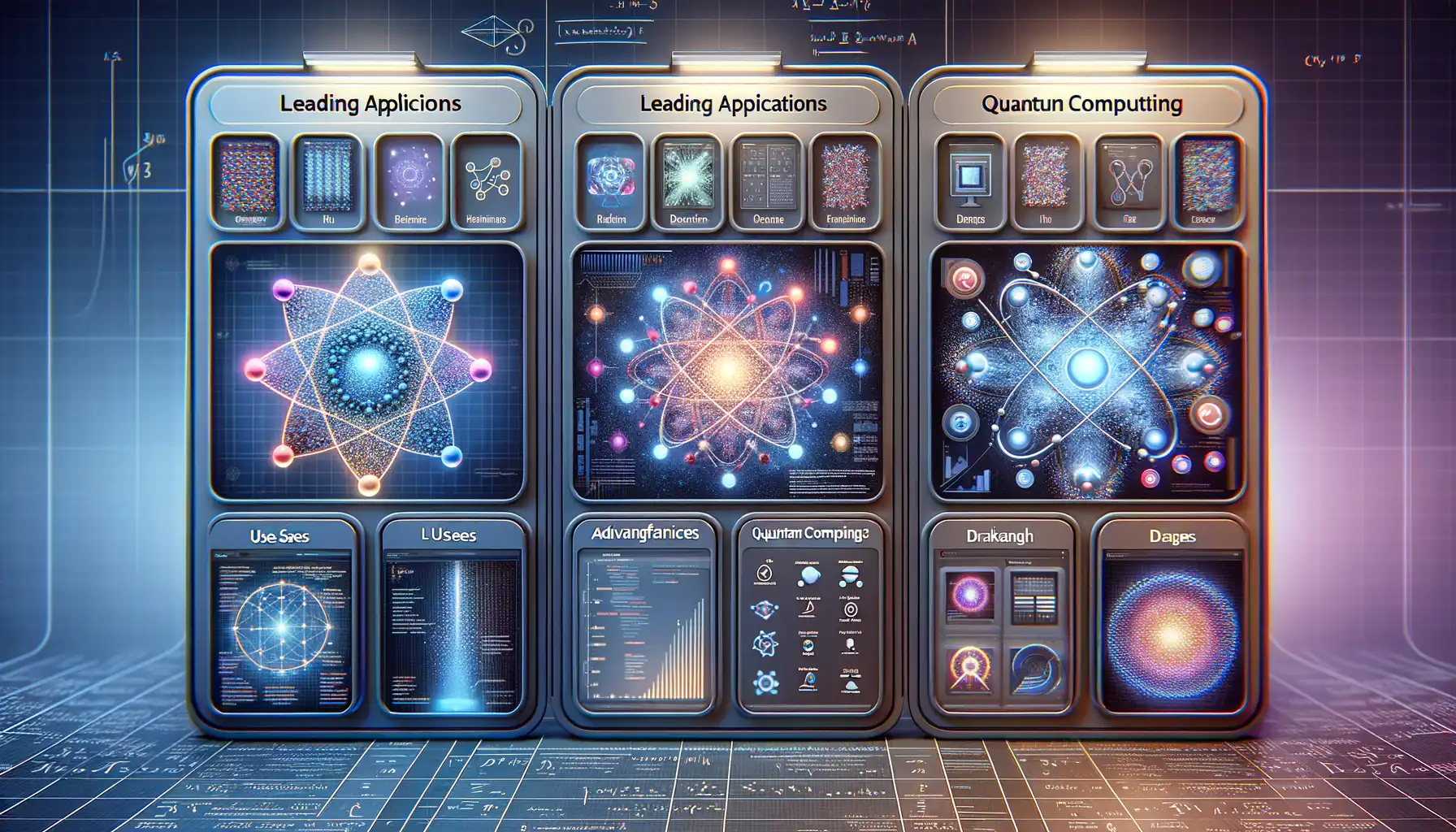Key Features to Look For in Quantum Computing Apps
Features That Make or Break a Quantum Computing App
When you’re diving into the universe of quantum computing through an app, it’s not just about shiny graphics or fancy animations. You want something that truly clicks with your learning style while delivering substance. Here’s what to keep an eye on—because these features can be game-changers.
- Interactive Simulations: Does the app let you tinker with quantum circuits? Imagine dragging and dropping gates, tweaking qubits, and witnessing instant results—it’s like having your own mini quantum lab in your pocket.
- Real-World Applications: Apps that tie quantum concepts back to real-life problems, like optimization or cryptography, don’t just educate—they inspire. Suddenly, Schrödinger’s cat has some practical context!
Personalization and Progress Tracking
Every quantum learner is unique, and the best apps know this. Look for tools that adapt: whether through personalized quizzes, tailored content recommendations, or progress dashboards that keep you motivated. One standout app even congratulated me for mastering superposition with a virtual fireworks display. Cheesy? Maybe. Effective? Absolutely.
And let’s not forget accessibility. Simplified interfaces are essential for beginners, but advanced users should have the freedom to dig deeper with features like Python coding integration or QASM tutorials. A great app doesn’t just teach—it grows with you.
Best Mobile Apps for Quantum Computing Education

Apps That Turn Quantum Mysteries Into Masterpieces
It’s mind-blowing to think that the complex, head-scratching world of quantum computing can now be explored through apps right on your phone. Whether you’re a curious beginner or someone aiming to dive deep into quantum algorithms, there’s an app designed just for you. Let’s explore a few gems that shimmer in this niche universe.
Imagine an app like Qiskit Playgrounds. It’s more than just a learning tool—it feels like having a quantum lab in your pocket. You can experiment with qubits, visualize superposition, and even run small-scale programs. It’s playful yet powerful, making quantum computing feel less like black magic and more like an art form you can sketch.
Or take Quantum Flytrap, where stunning visualizations meet hands-on interaction. This app is perfect for those of us who need to “see it to believe it.”
- Braket Workbench: For the ambitious learners—it syncs with real quantum systems!
- Quantum Infinity: Simplifies theory with bite-sized lessons and quizzes.
The best apps combine imagination with innovation, giving every learner that “aha!” moment when quantum weirdness finally clicks.
How Quantum Computing Apps Aid in Learning

Transforming Abstract Ideas into Tangible Learning
Quantum mechanics feels like a distant galaxy at first—mysterious, complex, and completely out of reach. But here’s the magic: quantum computing apps bring that galaxy closer. They don’t just teach; they make you feel quantum phenomena in action. Imagine seeing how particles can be waves or how qubits twist between 0 and 1—not as equations on a chalkboard, but through interactive visualizations that unfold before your eyes.
Take an app with a built-in simulator, for example. Suddenly, designing a quantum circuit isn’t a task for PhDs in ivory towers—it’s something you’re doing on your phone, experimenting with gates and seeing live results. It’s like building Legos, but instead of castles, you’re creating computational marvels.
Breaking Down the Complexity—One Tap at a Time
Quantum computing can overwhelm even the most curious minds. That’s where these apps excel: they deconstruct complex topics into bite-sized, digestible pieces. Here’s how they achieve it:
- Gamified learning modules: Who knew you could “play” with qubits? These games turn theoretical principles into fun challenges.
- Real-world applications: Many apps connect abstract lessons to fields like cryptography, AI, and more, showing why quantum theory matters.
- Interactive quizzes: Reinforce your knowledge with quick tests after engaging tutorials!
The result? A learning process that feels intuitive and exciting—like unlocking secret levels in your favorite game. By using touch, play, and experimentation, these apps ensure you don’t just learn; you absorb, explore, and even question.
Comparison of Top Quantum Computing Apps

Breaking Down the Best Quantum Computing Apps
When it comes to learning about quantum computing, not all apps are created equal. Some feel like a genie granting your wish for knowledge, while others might leave you scratching your head. So, how do you pick the right one? Let’s dive in and compare a few standout options that cater to different learning styles and goals.
Quantum Odyssey: Picture this app as a thrilling adventure into the quantum realm. Its interactive simulations aren’t just educational—they’re downright addictive. Build quantum circuits, see real-time outputs, and even experiment with noise effects. For hands-on learners, it’s a galaxy of “aha!” moments.
IBM Quantum Experience: This one feels like having your own private tutor… except it’s IBM. You don’t simply learn theory; you get to run code on *actual* quantum computers. For those who want to dip a toe in professional-grade tools, this app delivers in spades.
Quirk: Think minimalism meets problem-solving. It’s a sleek sandbox for building and visualizing gates. Perfect for beginners looking for clarity without overwhelming details.
- Best for Hands-On Learning: Quantum Odyssey
- Professional Level Insight: IBM Quantum Experience
- Simplified Visual Explanations: Quirk
Tips for Maximizing Your Learning Experience

Transform Your Study Space into a Quantum Haven
Your environment matters more than you think! To truly dive into the mind-bending world of quantum computing, start by crafting a space that energizes your curiosity. Think of it as setting the stage for a magic show—except here, the magic is in entangled particles and superposition.
Eliminate distractions. Put your phone on silent (unless you’re using one of those amazing apps we talked about earlier), grab a drink, and let your surroundings breathe focus. It’s easier to explore quantum theories when you’re not interrupted by notifications pinging like Schrödinger’s cat begging for attention!
Speaking of focus, set a goal for each session. For example, “Today, I’ll master the basics of quantum gates.” Small, clear targets help cut through the vastness of quantum concepts—a true lifesaver when everything feels like particles going every which way.
Leverage Features Hidden in Your Apps
Even the most cleverly designed apps hide treasures in plain sight. Tap beyond the basics—here’s how:
- Check for interactive modules. Ever tried simulating qubits? Many apps have them, and they’re game-changers for visual learners!
- Take quizzes. Testing what you’ve learned burns concepts into your brain, wielding the same magic as repetition but without the drudgery.
- Dive into forums or community boards. Many apps include access to fellow learners—imagine swapping ideas with someone as obsessed with quantum weirdness as you are!
Lastly, reward yourself. Tackling quantum computing isn’t easy—it’s like completing a marathon, only instead of running, you’re unweaving the fabric of reality. Treat yourself after a productive study session. Trust me, you’ve earned it!
